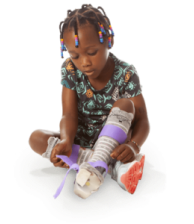What is periventricular leukomalacia?
Periventricular leukomalacia (PVL) is a type of birth injury that damages the white matter near the brain’s ventricles. These fluid-filled spaces help cushion and protect the brain and spinal cord.
White matter is responsible for carrying signals between brain cells and plays a key role in movement, learning, and communication.
“With PVL, there are spots of damage in the brain. Depending on how severe they are and where they’re located, it can affect how a child develops — their learning, motor skills, even speech.”
— Kristin Proctor, Cerebral Palsy Guide Registered Nurse
PVL most often develops during the third trimester or shortly after birth. Babies born prematurely or with very low birth weight are at a higher risk. Bleeding in the brain and untreated infections can also increase the likelihood of PVL.
In some cases, PVL may be preventable. When doctors fail to monitor or treat conditions that lead to this injury, families may be able to take legal action. Birth injury lawsuits have helped many families receive compensation for medical care, therapy, and long-term support.
We partner with experienced birth injury lawyers across the country who have secured over $1 billion for families.
Find out if we can help your family, too. Get a free case review right now.
Periventricular leukomalacia symptoms
Symptoms of periventricular leukomalacia can vary depending on how severe the brain injury is and where the white matter damage occurs.
Some children with mild PVL symptoms don't show physical signs at first but may have delays in thinking, learning, or communication. With more severe PVL brain damage, movement problems and muscle stiffness are common.
- Jerky or exaggerated movements
- Legs that cross or scissor when walking
- Tight or stiff muscles, especially in the legs
- Walking on tiptoes
Symptoms often become more noticeable as a child begins to miss developmental milestones, like sitting up or walking.
As the child grows, tight and contracted muscles can lead to pain, fatigue, and problems in other parts of the body. Joints and ligaments may become strained, further limiting mobility.
In severe cases, PVL can also affect vision and hearing or cause seizures. These symptoms tend to appear when the damage extends beyond the motor control areas of the brain.
Causes of periventricular leukomalacia
Periventricular leukomalacia develops when white tissue in the developing brain has died or been damaged from a lack of blood flow.
One known contributor to PVL is intraventricular hemorrhage (IVH), or bleeding into the brain’s ventricles. This can reduce oxygen delivery to nearby white matter, increasing the risk of permanent brain injury.
- Hypoxic-ischemic encephalopathy: This occurs due to limited blood flow or lack of oxygen to the brain, resulting in brain dysfunction.
- Low birth weight: Infants under 5 pounds and 8 ounces have a higher risk of complications affecting brain development.
- Maternal or neonatal infection: Infections before or after birth can trigger inflammation that damages brain tissue.
- Premature birth: Babies born before 32 weeks are more vulnerable to white matter damage.
In some cases, PVL may be the result of medical negligence. Doctors and nurses are trained to respond quickly to oxygen-related complications. When they fail to act, the consequences can be devastating.
If your child developed PVL that could have been prevented, your family may be eligible for financial compensation.
Get a free case review right now to see if you may qualify.
What does PVL lead to?
Periventricular leukomalacia can lead to long-term problems with movement, coordination, and muscle control. Because PVL damages the brain, many children with PVL go on to experience developmental delays or motor challenges.
In some cases, PVL may lead to cerebral palsy (CP), a lifelong condition that affects how a person moves and controls their muscles.
Periventricular leukomalacia and cerebral palsy
PVL is one of the leading causes of spastic cerebral palsy, especially in premature infants. Periventricular white matter injury disrupts the ability of a baby’s brain to communicate with the body, often resulting in muscle stiffness and tightness.
“There are some babies who, even at NICU discharge, are already known to be at high risk for developing cerebral palsy — especially from conditions like PVL. That white matter damage is what ultimately leads to CP.”
— Andi Lowe, Cerebral Palsy Guide Registered Nurse
A common form of CP linked to PVL is spastic diplegia, which primarily affects movement in the legs. Children with this type of CP may have trouble crawling, standing, or walking as they grow.
If you're concerned that your child’s PVL may lead to cerebral palsy, you likely have important questions.
Our nurses can help you understand what happened and what legal and medical options may be available to your family.
Connect with a registered nurse right now — it’s always free to talk with our team.
How is PVL diagnosed in newborns?
Getting an accurate PVL diagnosis is important, especially since early signs can be mistaken for other conditions that cause tight or stiff muscles.
Doctors typically begin with a physical exam to check for abnormal muscle tone, movement issues, or developmental delays that could suggest brain injury.
- MRI (magnetic resonance imaging): This scan creates detailed images of the brain and can show white matter damage, scarring, or tissue loss.
- Cranial ultrasound: Often used in premature babies, this test can detect bleeding, swelling, or fluid around the brain’s ventricles.
- CT scan (computed tomography): This test may be used if other results are unclear and can help identify structural changes or fluid buildup.
Once a PVL diagnosis is confirmed, your child’s doctor can explain how the injury may affect development and create a treatment plan.
Periventricular leukomalacia treatment options
While there is no way to reverse a PVL brain injury itself, treatment can help manage symptoms and support a child’s physical, cognitive, and emotional development.
The goal of PVL treatment is to reduce discomfort, improve mobility and communication, and enhance overall quality of life.
- Occupational therapy: This helps children develop the fine motor skills needed for daily tasks such as feeding, dressing, and brushing their teeth.
- Physical therapy: Targeted exercises can help loosen tight muscles, improve coordination, and increase strength and balance.
- Speech therapy: For children with delayed language or difficulty speaking, speech therapy focuses on improving communication and sometimes feeding skills.
Every child with PVL is different. Your child’s doctor will work with you to develop a personalized treatment plan based on their specific needs and challenges.
Periventricular leukomalacia prognosis


A periventricular leukomalacia prognosis refers to the long-term effects of the condition and how it may impact a child’s development. The outcome depends on how much white matter in the brain was damaged and the severity of symptoms as the child grows.
PVL causes permanent brain damage that cannot be reversed. The condition does not improve on its own over time.
Children with mild periventricular leukomalacia may have few physical symptoms and can often live independently with the right support. Early intervention and consistent therapy may improve their quality of life and help them reach important developmental goals.
In cases of severe PVL, children often face long-term challenges, including difficulty with movement, learning, vision, or speech. They may need ongoing medical care, assistive equipment, and help with daily tasks throughout their lives.
If your child’s PVL was caused by a preventable medical mistake, a birth injury settlement could help cover the cost of lifelong care.
Financial support can give your child access to the resources they need to reach their full potential and enjoy the best possible future.
Get legal help for periventricular leukomalacia
Unfortunately, some cases of periventricular leukomalacia could have been prevented with proper care during the birthing process.
Doctors, nurses, and other health care providers have a duty to uphold the standard of care in the delivery room. This includes recognizing warning signs, managing complications, and making sound decisions that protect the baby’s health.
When medical professionals fail to do their job and a child suffers brain damage as a result, they should be held accountable. Many families can take legal action through a birth injury lawsuit.
Compensation from a lawsuit can help cover the cost of care and give your child the support they need for the road ahead.
Cerebral Palsy Guide partners with top lawyers and law firms who can help families in all 50 states. So far, they’ve recovered over $1 billion for families affected by preventable birth injuries, including PVL.
Call our trained patient advocates at (855) 220-1101 or get a free case review right now to find out if we can help your family.





